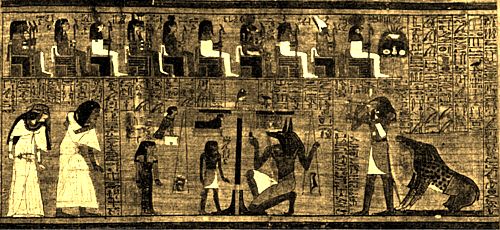|
What is
mummification?
In
Ancient Egypt, mummification was the process in which bodies
were coated in spices and wrapped in linen to preserve them and
stop them decomposing.
Why
did the Ancient Egyptians mummify the dead?
The
Ancient Egyptians believed that when a person died, their spirit
would live on in the afterlife. They believed that part of this
spirit remained with the body. Therefore, if the body was
destroyed then the spirit would be destroyed along with it.
Bodies were mummified to prevent this.
Who
was mummified in Ancient Egypt
Not all
Ancient Egyptians were mummified. Poor people were simply buried
in the sand. Only those that could afford it were mummified and
buried in tombs.
How
were mummies made?
1. The
brain was removed by pulling it out through the nose using an
iron hook. A liquid was used to clean out the bits that the hook
could not reach.
2. A long
slit was made in the left-hand side of the stomach. The liver,
lungs, stomach and intestines were removed and dried in natron
for 40 days. They were then wrapped in linen and placed into
canopic jars (see below). The heart was left as this was
believed to be the centre of intelligence.
3. The
body was washed in palm wine. Natron was packed inside and out
and it was also left for about 40 days to dry out.
4. Once
the body was dry, the remaining natron
was removed. The skin was
then washed and rubbed with oils to make it softer.
5. The
empty body was stuffed with sawdust, scraps of cloth and mud
from the river Nile. Small onions were sometimes used to replace
the eyes.
6. The
slit was sewn up and the body was wrapped in linen bandages.
These were soaked in resins and oils to glue the layers
together. Sometimes jewellery and protective amulets were added
to the body during this process.
7. A
death mask was placed over the bandaged head so that the dead
person would recognise themselves in the afterlife. These were
usually made from cartonnage but wood, silver and gold were also
sometimes used. The most famous death mask is that of
Tutankhamun.
What
were canopic jars?
After the
liver, lungs, stomach and intestines were removed from the body,
they were dried out in natron, wrapped in linen and then placed
into canopic jars. Each jar had the head of one of the sons of
the god Horus.
 |
| Imsety
had a human head. It was believed that he guarded the liver. |
|
| Hapy
had the head of a baboon. It was believed that he protected
the lungs. |
|

|
|

|
| Duamatef
had the head of a jackal. It was believed that he guarded the
stomach. |
|
| Qebehsenuf
had the head of a falcon. It was believed that he protected the
intestines. |
|

|
The
canopic jars were put into a chest which was placed in the tomb
with the mummy.
What
were the Fields of Yaru?
The
Ancient Egyptians believed that when they died they had to pass
through a dangerous realm filled with perils such as poisonous
snakes and fiery pits in order to reach the Fields of Yaru
(afterlife). To ensure safe passage, the dead person would need
to use the correct spells. These spells were often copied onto
papyrus and buried with them in their tomb.

The weighing of the heart of the scribe Ani
(Click on the various features for more information)
Before the Fields of Yaru
could be entered, the dead person had to face one more test in
the Hall of Ma'at (or truth). Their heart was taken as a measure
of their good and bad deeds. It was weighed against Ma'at's
feather, a symbol of truth. If the feather outweighed the heart
then that person had lead a good life and they were presented to
the god Osiris to enter the afterlife. However, if the heart
weighed more than the feather then it must be laden with their
evil deeds. Their heart was eaten by the demon Ammut, a creature
with the head of a crocodile, middle of a lion and hindquarters
of hippopotamus. This destroyed their soul.
The picture above shows
the weighing of the heart of a scribe called Ani. Click on the
various features to find out more.
|